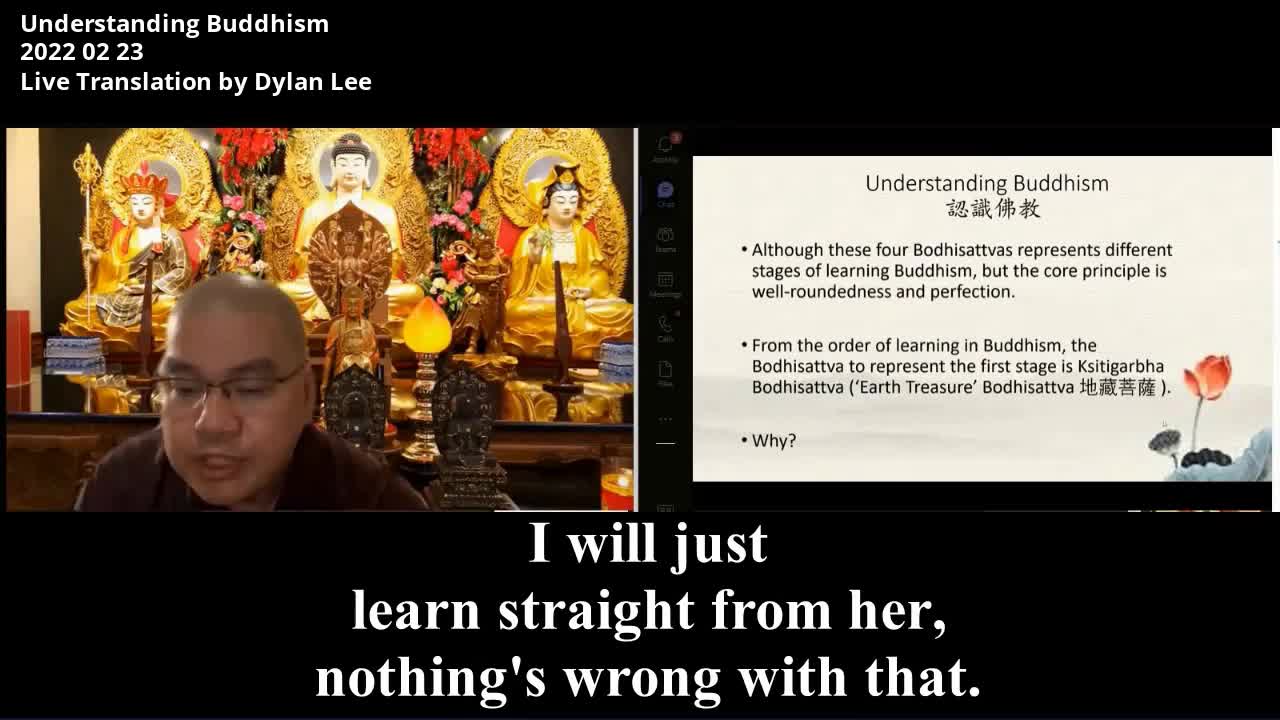Premium Only Content

1Ven Master Xue Wu 20220223 11 《Wisdom is to be able to see through the delusions in this world》
《Wisdom is to be able to see through the delusions in this world》
The teachings that were given by Shakyamuni Buddha can be categorized into 84,000 methods of cultivation and among so many methods that were given by him, how do we choose among so many choices? Every method given by Buddha is correct but which one is the one suitable for us?
This is a very important point for us, something we need to be concerned about when we're learning.
So when we are learning Buddhism, we go to a temple and burn incense to offer to the Buddha or offer flowers to the Triple Gem. Some people might think that's it for Buddhism, that's all that Buddhism is about. However, if you actually want to learn Buddhism, where do we start, where do we begin?
We must be clear and we must be aware of that, otherwise we will waste our time when we learn, otherwise we will spend years reaping nothing in return, learning nothing in return.
In the past, our patriarchs have said that everyone who chants Amituofo, practices this method, will be able to reach the Pure Land, no one will be left behind. But why, in reality, are so many people who chant Amituofo not getting there? It is because we have habits that stop us from getting there. What is the cause? What are the habits that stop us from getting to the Pure Land? That's what we need to discuss today. If we're not clear what obstacle lies in front of us, how do we get blessings, actual blessings, actual help from Buddha and Bodhisattvas?
If we do not understand how to begin learning Buddhism, unfortunately, it becomes a religion instead.
So that's what we will discuss today.
Where do we begin in learning Buddhism, where do we enter? Which door do we enter in this vast ocean?
In Chinese Mahayana Buddhism, we usually use Four Great Bodhisattvas as a method to educate everyone. In China, there are four very famous Buddhist mountains (that correspond to these Four Great Bodhisattvas). In Jiu Hua九華山(mountain) there's Ksitigarbha (DiZang) Bodhisattva, in Pu Tuo普陀山(mountain) there’s Guan Yin and in E Mei峨眉山(mountain) there’s Samantabhadra Bodhisattva (Pu Xian) and in WuTai五臺山(mountain) there’s Manjushri Bodhisattva. These are the Four Great Bodhisattvas and mountains that are commonly used in the education of Buddhism. So what do they represent? We must be clear what they represent, what do these Four Great Bodhisattvas symbolize?
They show when we learn Buddhism, we need to have an order of learning, we need to have a sequence, we need to follow certain steps, a sequence when we learn Buddhism, step one, step two, step three, step four, one by one, step by step.
Why? It is because it depends on our capability, like you're born with a certain capability. Some people who are, what we call genius, can immediately reach the highest level in Buddhism, but for us on the common level, we need to follow the steps, one by one, so that we can learn it, we can actually learn them. So of these Four Great Bodhisattvas, among all four of them, with whom do we start? It's a very important question.
What do they represent? The spirit, as in what value do they represent? Each of them represents one of the four core values when we're learning Buddhism that we need to master, we need to grasp. As a Buddhist we need to master and hold on to these values. What are these Four Values that we should learn from Bodhisattvas? We will talk about that in detail later. For example, what does Ksitigarbha Bodhisattva or in Chinese Dizang which translates to Earth Treasure represent? What level of attainment? Other than order of learning, the second one is the level of attainment in Buddhism. What is the level of attainment? That means the level of wisdom, the scale, the depth, the horizon of their wisdom, which level do they represent?
Number three is to improve your capability, your skills, your wisdom to see through the delusions in this world, we call it the Saha World or the world that is messy, full of false views and false thoughts. How do you see through it, knowing right and wrong? How do you solve it? It all relies on the level of your attainment. If our level of attainment did not increase, how do we have wisdom?
Higher wisdom means our level of attainment is better and we can get better at handling the world. These Four Great Bodhisattvas represent that so we need to learn about that.
All of these Four Great Bodhisattvas represent different aspects, different spirits, stages of learning Buddhism. What does Manjushri Bodhisattva or the Universal Worthy Bodhisattva represent?
They all represent different values but their goal, their principle, all encompass one another, we call it well-roundedness.
For example, Ksitigarbha Bodhisattva, whatever value he represents, whatever virtues he has, Guan Yin Bodhisattva has it, Manjushri Bodhisattva has it, Universal Worthy Bodhisattva has it. Four is one, one is four. Each one of them has a very specialized virtue but each of the others have the same virtues, they are just trying to stand out to help us.
Among the four of them, we do need to know the order of learning, where do we start and then where do we end. There's a reason why there are four of them. You cannot jump the queue. you can't be like: “I like Guan Yin Bodhisattva, I will just learn straight from her, nothing's wrong with that. Manjushri Bodhisattva represents wisdom, I will learn straight from him, nothing's wrong with that.”
-
 LIVE
LIVE
Glenn Greenwald
5 hours agoUN Gaza Investigator Francesca Albanese on US Sanctions Against Her; Plus: Glenn Takes Your Questions on Trump's Pressure on Brazil, Sam Harris, Bill Ackman, and More | SYSTEM UPDATE #485
1,047 watching -
 LIVE
LIVE
The Jimmy Dore Show
3 hours agoBill O’Reilly GLAD Gov’t Lying About Epstein! New Freedom Flotilla Going to Gaza! w/Christian Smalls
10,960 watching -
 58:37
58:37
BonginoReport
9 hours agoElon’s Petty Move Threatens GOP’s Bright Future - Nightly Scroll w/ Hayley Caronia (Ep.88)
10.6K17 -
 LIVE
LIVE
Dr Disrespect
7 hours ago🔴LIVE - DR DISRESPECT - INSANE WARZONE CHALLENGES! DOMINATING 2025 HYPE
1,152 watching -
 24:53
24:53
Preston Stewart
4 hours agoTrump Arms Ukraine
21 -
 LIVE
LIVE
LFA TV
20 hours agoLFA TV ALL DAY STREAM - FRIDAY 7/11/25
962 watching -
 1:13:26
1:13:26
Kim Iversen
3 hours agoDershowitz Says He Knows FOR A FACT The Names On The Epstein List
19.1K33 -
 LIVE
LIVE
Nerdrotic
4 hours ago $7.53 earnedSuperman's James Gunn DROPS! Comic Book Movies Saved? WOKE Black Superman | Friday Night Tights 362
2,560 watching -
 42:44
42:44
American Minute with Bill Federer
2 hours ago $1.03 earnedHistory You Need to Know with Dr. Bill Federer
7.37K3 -
 32:52
32:52
Clownfish TV
4 hours agoI Watched SUPERMAN So You Don't Have To...
3.5K10